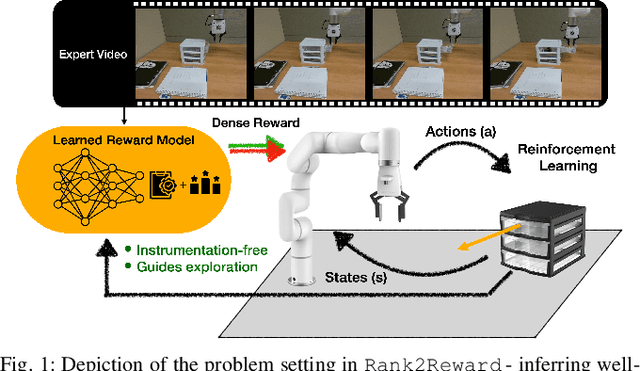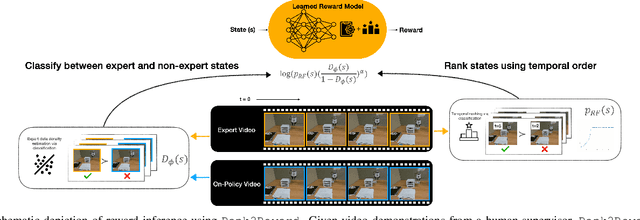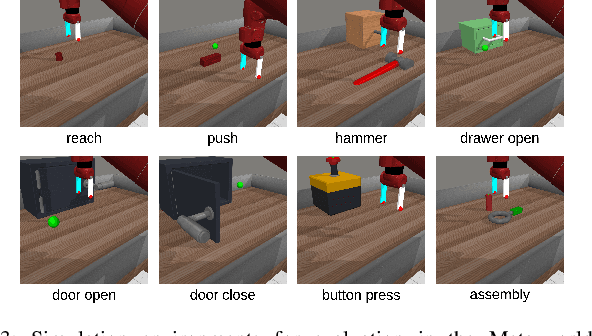Jacob Berg
Semantic World Models
Oct 22, 2025Abstract:Planning with world models offers a powerful paradigm for robotic control. Conventional approaches train a model to predict future frames conditioned on current frames and actions, which can then be used for planning. However, the objective of predicting future pixels is often at odds with the actual planning objective; strong pixel reconstruction does not always correlate with good planning decisions. This paper posits that instead of reconstructing future frames as pixels, world models only need to predict task-relevant semantic information about the future. For such prediction the paper poses world modeling as a visual question answering problem about semantic information in future frames. This perspective allows world modeling to be approached with the same tools underlying vision language models. Thus vision language models can be trained as "semantic" world models through a supervised finetuning process on image-action-text data, enabling planning for decision-making while inheriting many of the generalization and robustness properties from the pretrained vision-language models. The paper demonstrates how such a semantic world model can be used for policy improvement on open-ended robotics tasks, leading to significant generalization improvements over typical paradigms of reconstruction-based action-conditional world modeling. Website available at https://weirdlabuw.github.io/swm.
STRAP: Robot Sub-Trajectory Retrieval for Augmented Policy Learning
Dec 19, 2024Abstract:Robot learning is witnessing a significant increase in the size, diversity, and complexity of pre-collected datasets, mirroring trends in domains such as natural language processing and computer vision. Many robot learning methods treat such datasets as multi-task expert data and learn a multi-task, generalist policy by training broadly across them. Notably, while these generalist policies can improve the average performance across many tasks, the performance of generalist policies on any one task is often suboptimal due to negative transfer between partitions of the data, compared to task-specific specialist policies. In this work, we argue for the paradigm of training policies during deployment given the scenarios they encounter: rather than deploying pre-trained policies to unseen problems in a zero-shot manner, we non-parametrically retrieve and train models directly on relevant data at test time. Furthermore, we show that many robotics tasks share considerable amounts of low-level behaviors and that retrieval at the "sub"-trajectory granularity enables significantly improved data utilization, generalization, and robustness in adapting policies to novel problems. In contrast, existing full-trajectory retrieval methods tend to underutilize the data and miss out on shared cross-task content. This work proposes STRAP, a technique for leveraging pre-trained vision foundation models and dynamic time warping to retrieve sub-sequences of trajectories from large training corpora in a robust fashion. STRAP outperforms both prior retrieval algorithms and multi-task learning methods in simulated and real experiments, showing the ability to scale to much larger offline datasets in the real world as well as the ability to learn robust control policies with just a handful of real-world demonstrations.
Rank2Reward: Learning Shaped Reward Functions from Passive Video
Apr 23, 2024



Abstract:Teaching robots novel skills with demonstrations via human-in-the-loop data collection techniques like kinesthetic teaching or teleoperation puts a heavy burden on human supervisors. In contrast to this paradigm, it is often significantly easier to provide raw, action-free visual data of tasks being performed. Moreover, this data can even be mined from video datasets or the web. Ideally, this data can serve to guide robot learning for new tasks in novel environments, informing both "what" to do and "how" to do it. A powerful way to encode both the "what" and the "how" is to infer a well-shaped reward function for reinforcement learning. The challenge is determining how to ground visual demonstration inputs into a well-shaped and informative reward function. We propose a technique Rank2Reward for learning behaviors from videos of tasks being performed without access to any low-level states and actions. We do so by leveraging the videos to learn a reward function that measures incremental "progress" through a task by learning how to temporally rank the video frames in a demonstration. By inferring an appropriate ranking, the reward function is able to guide reinforcement learning by indicating when task progress is being made. This ranking function can be integrated into an adversarial imitation learning scheme resulting in an algorithm that can learn behaviors without exploiting the learned reward function. We demonstrate the effectiveness of Rank2Reward at learning behaviors from raw video on a number of tabletop manipulation tasks in both simulations and on a real-world robotic arm. We also demonstrate how Rank2Reward can be easily extended to be applicable to web-scale video datasets.
SERL: A Software Suite for Sample-Efficient Robotic Reinforcement Learning
Feb 01, 2024Abstract:In recent years, significant progress has been made in the field of robotic reinforcement learning (RL), enabling methods that handle complex image observations, train in the real world, and incorporate auxiliary data, such as demonstrations and prior experience. However, despite these advances, robotic RL remains hard to use. It is acknowledged among practitioners that the particular implementation details of these algorithms are often just as important (if not more so) for performance as the choice of algorithm. We posit that a significant challenge to widespread adoption of robotic RL, as well as further development of robotic RL methods, is the comparative inaccessibility of such methods. To address this challenge, we developed a carefully implemented library containing a sample efficient off-policy deep RL method, together with methods for computing rewards and resetting the environment, a high-quality controller for a widely-adopted robot, and a number of challenging example tasks. We provide this library as a resource for the community, describe its design choices, and present experimental results. Perhaps surprisingly, we find that our implementation can achieve very efficient learning, acquiring policies for PCB board assembly, cable routing, and object relocation between 25 to 50 minutes of training per policy on average, improving over state-of-the-art results reported for similar tasks in the literature. These policies achieve perfect or near-perfect success rates, extreme robustness even under perturbations, and exhibit emergent recovery and correction behaviors. We hope that these promising results and our high-quality open-source implementation will provide a tool for the robotics community to facilitate further developments in robotic RL. Our code, documentation, and videos can be found at https://serl-robot.github.io/
 Add to Chrome
Add to Chrome Add to Firefox
Add to Firefox Add to Edge
Add to Edge